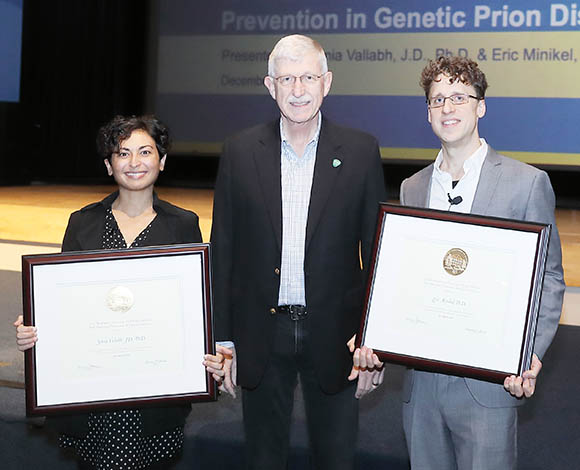A Giant Leap of Love, Faith, and Courage
A Husband-Wife’s Quest to Cure a Genetic Prion Disease

CREDIT: CHIA-CHI “CHARLIE” CHANG
NIH Director Francis Collins (center) and WALS presenters Sonia Vallabh (left) and her husband Eric Minikel, who are in search of a cure for prion disease. Vallabh and Minikel are each holding a framed certificate commemorating their talk.
Sonia Vallabh and her husband Eric Minikel hadn’t set out to build careers in science. Vallabh graduated with a law degree cum laude from the Harvard Law School (Cambridge, Massachusetts) in 2010 and joined a consulting firm in 2011. That same year, Minikel was working as a city planner after obtaining a master’s degree from the Massachusetts Institute of Technology (Cambridge, Massachusetts) in transportation and city planning. A tragic event, however, would change their lives forever. The couple described their saga at the Wednesday Afternoon Lecture Series (WALS) talk held on December 4, 2019.
Vallabh’s mother, Kamni Vallabh, underwent a catastrophic health decline that began late in 2009. What started out as failing eyesight, forgetfulness, and difficulty sleeping progressed rapidly to severe dementia. Within a year, Kamni was on life support, and in December 2010, she died. She was only 52 years old. An autopsy revealed that an incurable genetic prion disease called fatal familial insomnia had killed her.
Prion diseases occur in people and other mammals. Prions are misfolded proteins that induce the misfolding of the normal form of the same proteins in the brain; the accumulation triggers a rapidly progressing, always fatal, neurodegenerative disease. About 85% of cases are sporadic; 15% are genetic with mutations found in the prion protein gene, PRNP. Until recently, all attempts to find treatments had failed.
Another devastating realization for the couple came in December 2011 when Vallabh learned that she was carrying the fatal genetic mutation, too. It meant that she has a more than 90% chance of developing the disease, although it might not appear for 20 years. With the clock ticking, the couple decided that the only way to find a cure was to become patient-scientists themselves. They started learning all they could about prions. In early 2012, they enrolled in night classes at MIT and Harvard. They found entry-level jobs in science labs and applied to Ph.D. programs. They earned their Ph.D.’s in 2019 working on the prion question in the lab of Stuart Schreiber at the Broad Institute (Cambridge, Massachusetts). Their education also included brief predoctoral stints in the lab of Byron Caughey at the National Institute of Allergy and Infectious Diseases’ Rocky Mountains Laboratories in Hamilton, Montana.
Caughey’s lab has made important contributions to the understanding of how prions propagate their shape. He developed an assay (called RT-QuIC) to diagnose prion diseases. He, Vallabh, and Minikel have collaborated to show that mice treated with antisense oligonucleotides (ASOs) against PRNP RNA—either prophylactically or late in the course of disease—have markedly extended survival times (JCI Insight 4:e131175, 2019). Although Caughey is optimistic about the ASO technology, he cautions that a single approach might not be fully effective. Scientists must also find alternate therapies that directly target the misfolded form, he said.
Vallabh and Minikel, who now run an independent lab at the Broad Institute, are determined to find a cure for prion disease. A large pharmaceutical firm is developing an ASO against the human PRNP gene and is collaborating to help carry forward the couple’s work, said Minikel.
Listening to Vallabh and Minikel talk leaves one with a sense of awe at their incredible display of courage and endurance as they inch toward their goal. Their love and faith in each other gives them the strength to fight, they said. We have heard that love can move mountains. It may be a first when love conquers a genetic disease.
To see a videocast of the WALS December 4, 2019, lecture, go to https://videocast.nih.gov/summary.asp?Live=35113&bhcp=1.
This page was last updated on Tuesday, March 29, 2022
